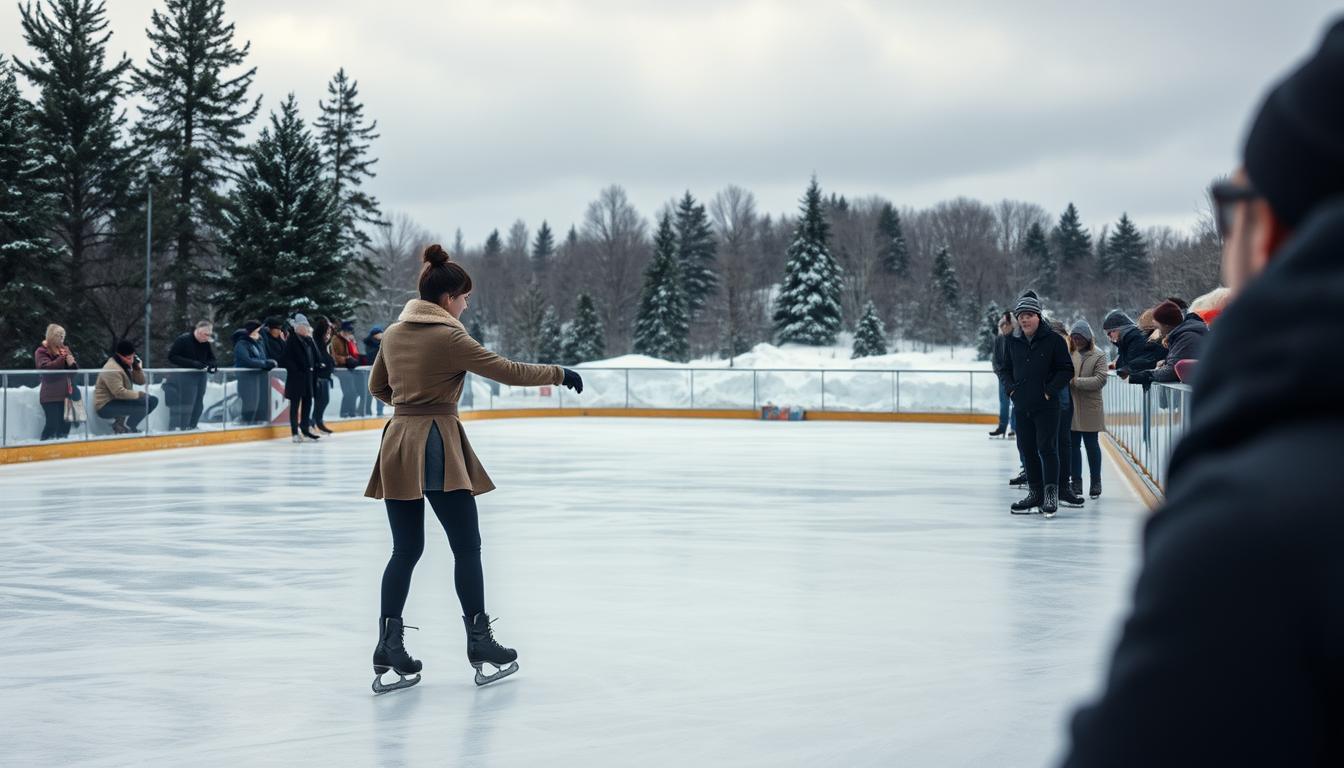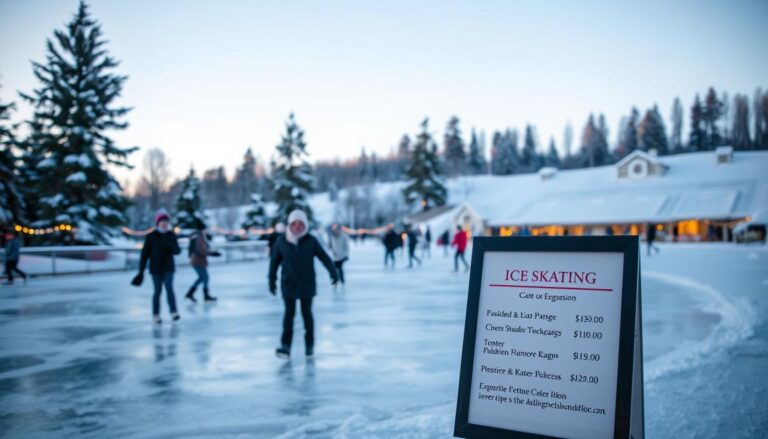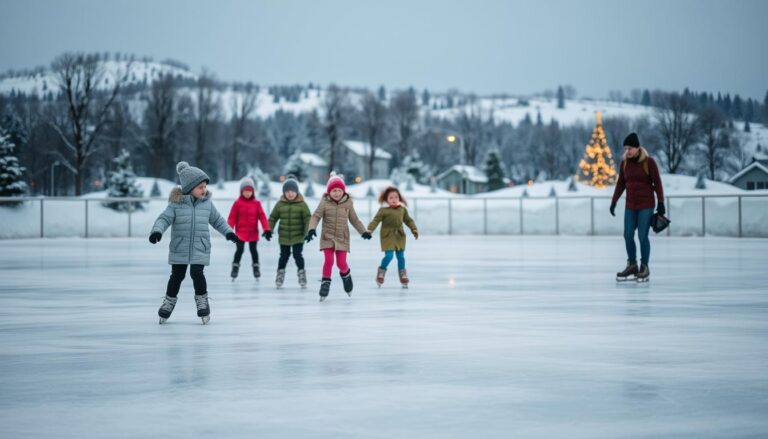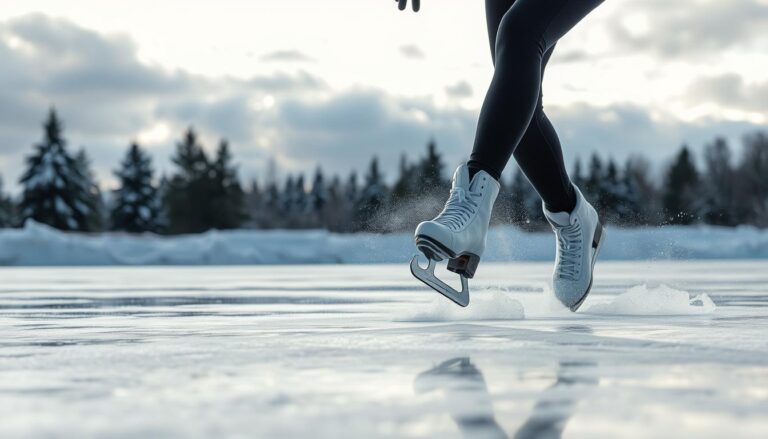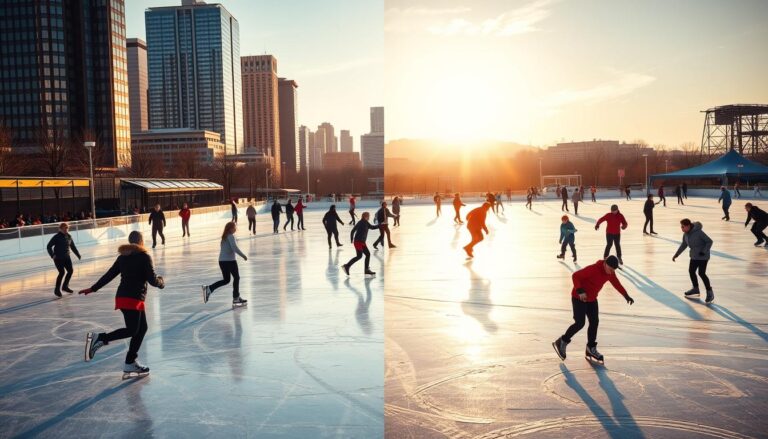Stopping on Ice Skates: Essential Techniques to Learn
Imagine gliding on a clean ice rink, feeling the cool air on your face. You need to stop, but how? Learning to stop on ice skates is key for safety and confidence.
Stopping on ice isn’t just about avoiding falls. It’s about moving with precision and grace. Whether you’re a beginner or improving your skills, knowing how to stop is essential.
This guide will teach you everything about stopping on ice skates. You’ll learn expert methods to control your speed, avoid accidents, and skate with confidence.
Ice skating techniques are an art that combines balance, control, and strategy. These stopping methods will help you improve, whether for a casual skate or advanced skills.
Are you ready to master ice skating stops? Your journey to becoming a better skater starts here. Let’s explore the basic techniques to keep you safe and in control.
Understanding the Fundamentals of Ice Skating Stops
Learning to stop on ice is key for beginners. It turns your skating from shaky to smooth. Knowing the basics of stopping helps you stay safe and in control.
Basic Physics Behind Ice Skating Stops
Stopping on ice uses basic physics. Friction and momentum are key. By pressing down on your blades, you create resistance, slowing you down.
- Blade angle determines stopping efficiency
- Weight distribution impacts stopping power
- Muscle control influences stopping technique
Essential Safety Considerations
Always put safety first when learning to skate. Good technique prevents injuries and boosts confidence. Beginners should focus on controlled movements and body mechanics.
| Safety Aspect | Recommended Practice |
|---|---|
| Balance | Maintain low center of gravity |
| Protective Gear | Wear helmet, wrist guards, knee pads |
| Initial Training | Practice near rink walls for support |
Required Equipment for Safe Stopping
Choosing the right gear is vital for beginners. Good skates with sharp blades are essential for stopping well.
- Comfortable, supportive skating boots
- Blades with proper edge alignment
- Thick socks for cushioning
- Protective padding
By grasping these basics, you’ll lay a strong foundation for safe and confident stops on ice.
Proper Body Positioning for Effective Stopping
Learning to stop in ice skating starts with body positioning. Your stance affects how well you can stop. A good ice skating tutorial will improve your technique.
Your body’s core alignment is key to a solid stop. Think of it as a stable base for control. How you distribute your weight is vital to avoid slipping or falling.
- Keep your knees slightly bent for better balance
- Center your weight over the middle of your skates
- Maintain an upright but relaxed upper body
- Engage your core muscles for stability
Arm positioning is also important for stopping. Your arms should be relaxed but ready to help balance. Extend them slightly away from your body to control your movement.
| Body Part | Correct Position | Common Mistake |
|---|---|---|
| Knees | Slightly bent | Completely straight |
| Arms | Relaxed, slightly extended | Stiff or tucked close to body |
| Weight Distribution | Centered over skates | Leaning too far forward or back |
Practice is key to mastering the stopping stance. Start slowly and focus on your body alignment before attempting faster stops. With regular practice, your body will learn the best stopping position.
The Snowplow Stop: Your First Stopping Technique
Learning to stop is key for ice skating beginners. The snowplow stop is a simple way to stop smoothly on the ice. It builds confidence and lays the groundwork for more advanced stops.
For new skaters, mastering the snowplow stop is a big deal. It’s the main technique for controlling speed and stopping safely.
Step-by-Step Snowplow Instructions
- Start in a basic skating stance with knees slightly bent
- Gradually push your heels outward, creating a pizza slice or wedge shape with your skates
- Apply gentle pressure to the inside edges of your blades
- Shift your weight evenly between both feet
- Maintain a low center of gravity for better balance
Common Snowplow Stop Mistakes
- Keeping legs too stiff
- Not bending knees enough
- Pushing feet too far apart
- Leaning backward instead of staying centered
Practice Drills for the Snowplow
To get better at the snowplow stop, try these drills:
| Drill Name | Focus Area | Duration |
|---|---|---|
| Stationary Wedge | Balance and Edge Control | 5-10 minutes |
| Slow Glide Stop | Speed Management | 10-15 minutes |
| Gradual Descent Stops | Confidence Building | 15-20 minutes |
Remember, practice is key in ice skating. Don’t worry if you struggle at first. Every try gets you closer to mastering the snowplow stop.
T-Stop: Mastering the Classic Stopping Method
Ice skating lessons often teach the T-stop as a key skill. It helps skaters control their movement on the ice. This method adds precision and style to their skating.
To do a T-stop, you need to position your body right and control your edges. You make a T-shape with your blades. One foot stops you by creating friction, while the other foot helps you slow down smoothly.
- Position your dominant foot parallel to the direction of travel
- Slide the other foot perpendicular behind or beside the moving foot
- Apply gentle pressure to create stopping friction
- Maintain balanced body weight distribution
Learning the T-stop takes practice. Practice makes perfect in mastering this elegant stop.
| Skill Level | Difficulty | Practice Time |
|---|---|---|
| Beginner | Moderate | 2-3 weeks |
| Intermediate | Easy | 1 week |
| Advanced | Simple | Few days |
Experts say to start slow and control your movements. Focus on balance and shifting your weight to get the T-stop right.
Hockey Stop: Advanced Stopping Technique
The hockey stop is the top skill in ice skating stopping. It’s both tough and thrilling for skaters. This method combines speed, precision, and style.
Learning the hockey stop takes hard work and patience. It turns regular skating into a pro-level skill. It wows both new and seasoned skaters.
Preparing for the Hockey Stop
To master the hockey stop, you need to prepare well. Skaters should focus on:
- Strong core muscle strength
- Good edge control
- Confidence in maintaining balance
- Proper skating posture
Executing the Perfect Hockey Stop
To do a hockey stop, follow these steps:
- Build moderate skating speed
- Shift weight slightly forward
- Turn skates sideways at a 45-degree angle
- Apply pressure to inside edges
- Dig edges into ice while maintaining balance
Troubleshooting Hockey Stop Issues
| Common Problem | Solution |
|---|---|
| Losing balance | Practice lower body positioning |
| Inadequate stopping power | Improve edge control techniques |
| Uneven stop | Focus on symmetrical weight distribution |
Pro tip: Protective gear is essential when learning advanced stopping techniques. Always prioritize safety during practice.
Ice Skating How to Stop: Complete Guide for Beginners

Learning to stop is key for any new ice skater. This guide will teach you the basic stopping techniques. It will help you go from being nervous to feeling confident on the ice.
As a beginner, you’ll learn three main stopping methods:
- Snowplow Stop (Easiest for Beginners)
- T-Stop (Intermediate Technique)
- Hockey Stop (Advanced Skill)
Each stop takes practice and patience. Don’t get discouraged if you don’t nail it immediately! The snowplow stop is a great place to start. It involves turning your toes inward and pushing your heels out, slowing you down.
Always put safety first when learning to stop. Wear protective gear like:
- Helmet
- Wrist guards
- Knee pads
- Padded shorts
Improving in ice skating takes regular practice and building skills slowly. Start with slow movements and build your confidence. Remember, every pro started where you are now, learning the basics.
Pro tip for beginner ice skating: Practice your stops near the rink’s wall first. It’s safer and helps you feel more confident while learning.
Building Confidence Through Progressive Practice
Learning to stop in ice skating needs patience, practice, and smart learning. Your journey to becoming a confident skater starts with understanding how to build skills progressively and safely.
Ice skating lessons work best when you create a structured practice environment. This environment should minimize risks and maximize learning opportunities. The key is to break down stopping techniques into manageable steps. These steps gradually build your confidence and skill level.
Safety-First Approach to Practice
Safety is always your top priority when learning to stop on ice skates. Start with essential protective gear:
- Helmet for head protection
- Wrist guards to prevent injuries
- Padded shorts for hip protection
- Properly fitted ice skates
Recommended Practice Routines
Develop your stopping skills through these progressive practice routines:
- Stationary Stopping Drills
- Practice weight distribution
- Learn edge control
- Master basic body positioning
- Slow-Movement Stopping
- Start with minimal gliding
- Gradually increase speed
- Focus on consistent technique
- Confidence-Building Exercises
- Practice on different ice surfaces
- Try stopping from various speeds
- Develop muscle memory
Remember, progress in stopping in ice skating comes from consistent, focused practice. Each session builds your skills and confidence. You’ll go from a tentative beginner to a skilled ice skater.
Common Stopping Mistakes and How to Avoid Them
Learning to stop on ice is key to mastering ice skating. Even pros struggle with stopping at first. Knowing these common mistakes can boost your skills and confidence.
Here are the top stopping errors that can slow your progress:
- Leaning Back Too Far: This classic mistake reduces your control and increases fall risk
- Stiff Leg Positioning: Prevents smooth and controlled stops
- Incorrect Weight Distribution: Throws off your balance during stopping
- Panicking Instead of Controlling Your Movement
Ice skating techniques need precise body mechanics. Skaters often make these mistakes due to fear or lack of training.
| Mistake | Consequence | Correction Strategy |
|---|---|---|
| Leaning Backward | Loss of Balance | Keep Center of Gravity Over Skating Blades |
| Stiff Legs | Reduced Maneuverability | Practice Flexible Knee Bend |
| Improper Weight Shift | Unstable Stops | Focus on Gradual Weight Transfer |
Professional skaters say mastering ice skating stops is about muscle memory. Start slow, then increase speed and confidence.
- Practice on soft ice initially
- Use protective gear while learning
- Take lessons from certified instructors
- Watch professional skaters’ techniques
Remember, every expert was once a beginner. Your stopping technique will improve with patient, consistent practice and a willingness to learn from your mistakes.
Advanced Stopping Techniques for Experienced Skaters
As you get better at ice skating, learning advanced stopping techniques is key. These skills are not just for fun but also for safety. They show off your skill and control on the ice.
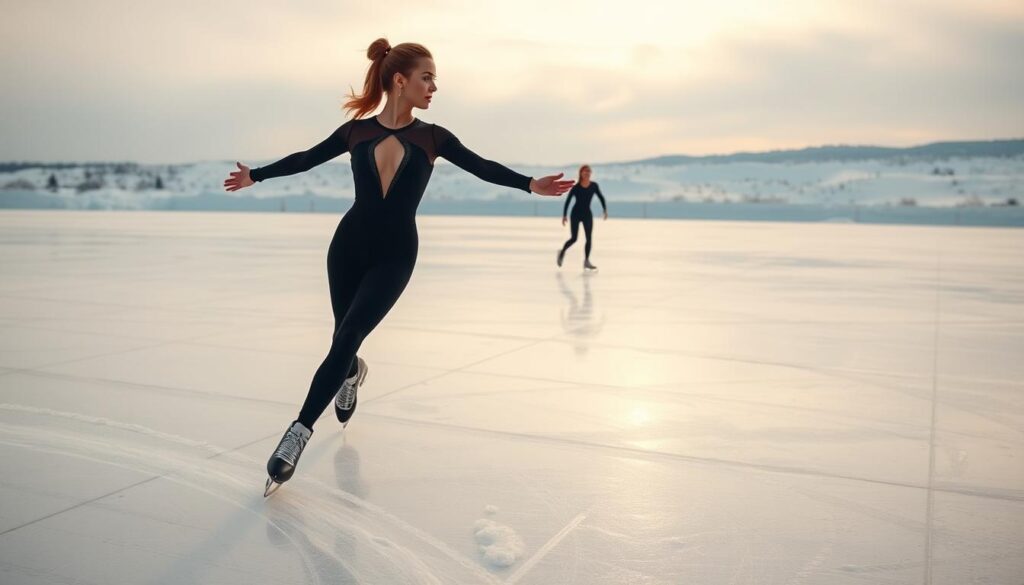
For those who have been skating for a while, it’s time to learn more. You’ll need to master techniques that show off your precision and style. These skills take practice, balance, and confidence.
Exploring One-Foot Stops
One-foot stops are a big step up in your skating skills. They require great balance and control. You’ll need to focus all your weight on one blade.
- Develop core strength for stability
- Practice weight distribution
- Maintain proper ankle alignment
- Start with slow, controlled movements
Mastering Power Stops
Power stops show off your skating skills. They let you stop fast while keeping a cool stance.
- Approach with moderate speed
- Shift body weight decisively
- Angle skate blades perpendicular to direction
- Engage core muscles for balance
- Practice on smooth, clean ice surfaces
Pro Tip: Always wear protective gear when trying out these advanced stops. Start slow to avoid getting hurt.
Stopping While Skating Backwards
Learning to stop while skating backwards is a big challenge. It requires skill and confidence. Even experienced skaters find it tough, needing to control their body and edges well.
Stopping backwards is a key skill in ice skating lessons. It shows if a skater is a beginner or more advanced. Skaters must learn how to control their speed and stop safely.
- Understand weight distribution
- Practice edge control
- Develop core stability
- Learn proper body positioning
The main ways to stop backwards include:
- Backward Snowplow Stop
- Mohawk Stop
- One-Foot Backward Stop
Stopping backwards needs balance, technique, and confidence. Skaters must move their weight carefully. They also need to keep their center of gravity low to avoid falling.
| Stopping Technique | Difficulty Level | Key Skills Required |
|---|---|---|
| Backward Snowplow | Intermediate | Edge control, leg strength |
| Mohawk Stop | Advanced | Rotational balance, quick weight transfer |
| One-Foot Backward Stop | Expert | Precise edge control, core stability |
Practice is key to mastering these advanced techniques. Start slow and build your confidence as you get better at each stop.
Emergency Stopping Techniques for Quick Reactions
Learning to stop quickly in ice skating is key for all skaters. It’s vital when you face unexpected obstacles or need to stop fast in crowded rinks. For beginners, mastering split-second stops can help avoid accidents.
Knowing how to stop fast boosts your confidence on the ice. Skaters need to learn quick responses to keep themselves and others safe.
Emergency Fall Prevention Strategies
- Maintain a low center of gravity
- Keep knees slightly bent
- Practice peripheral awareness
- Stay relaxed but alert
Quick Response Stopping Methods
Stopping in ice skating needs specific skills that come with practice. Here are some key emergency stopping methods:
| Technique | Difficulty Level | Effectiveness |
|---|---|---|
| Snowplow Stop | Beginner | High |
| T-Stop | Intermediate | Medium |
| Hockey Stop | Advanced | Very High |
Experts say to build muscle memory by practicing a lot. Start slow and build up your stopping skills. Remember, controlled panic is better than uncontrolled fear.
Maintaining Your Skates for Optimal Stopping Power
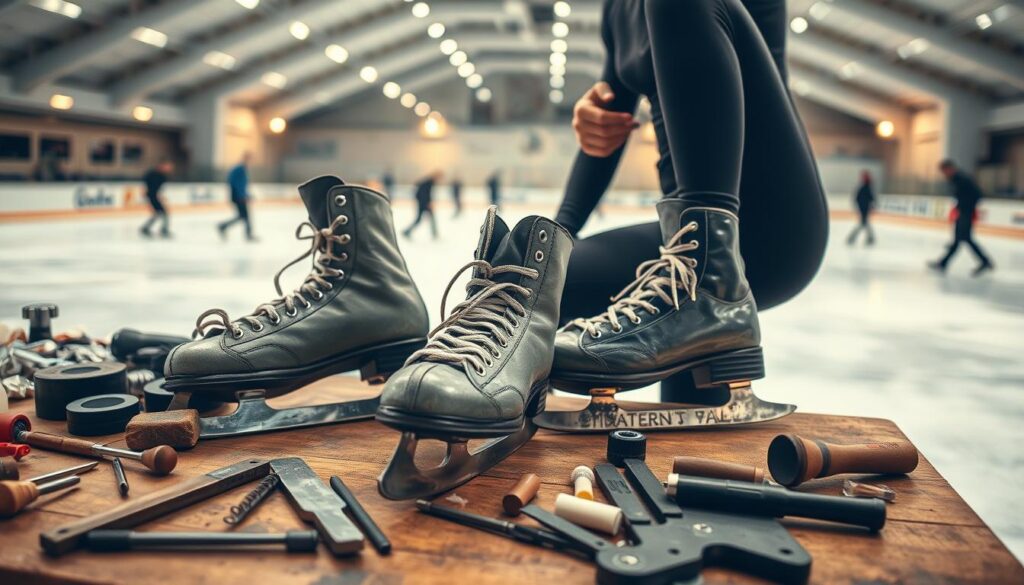
Ice skating is more than just knowing how to move on the ice. It’s also about having the right gear. Your skates are key to your connection with the ice, and they’re vital for stopping smoothly.
Keeping your blades sharp and in line is essential for stopping well. Blades that are sharp and aligned help you control your movements on the ice. This makes your skating better and more enjoyable.
- Inspect blades regularly for nicks and rust
- Clean blades after each skating session
- Store skates in protective guards
- Dry blades thoroughly to prevent corrosion
Knowing about blade profiles can really help your stopping skills. Different skating styles need different blade setups. These setups help with control and balance.
| Blade Type | Best For | Stopping Performance |
|---|---|---|
| Flat Ground | Recreational Skating | Good |
| Curved Profile | Advanced Techniques | Excellent |
| Rocker Blade | Figure Skating | Superior |
Experts say to sharpen your blades every year for the best performance. This simple step can make a big difference in your stopping power and overall skating.
Spending time on skate care is key to getting better at ice skating. By following these tips, you’ll make sure your gear supports your skills. This way, you can stop with confidence.
Adapting Stopping Techniques to Different Ice Conditions
Ice skating techniques need you to know the ice you’re on. Not all ice is the same, so your stopping method must change. Learning how to stop on ice means knowing the ice’s unique traits.
Skaters face many ice types that need special stopping ways. Being able to change quickly can stop you from falling.
Understanding Ice Surface Variations
Different ice types offer unique stopping challenges. Here are key things to think about:
- Temperature impact on ice texture
- Surface smoothness
- Indoor vs. outdoor skating environments
- Time of day and ambient conditions
Stopping on Hard Ice
Hard ice needs sharp stopping and edge control. Your skates will slip more, so you must move carefully.
| Ice Condition | Stopping Technique | Key Considerations |
|---|---|---|
| Extremely Hard Ice | Controlled Snowplow | Minimal pressure, gradual edge engagement |
| Cold Indoor Rink | T-Stop | Precise angle, reduced friction |
| Compressed Surface | Hockey Stop | Sharp blade angle, quick deceleration |
Adjusting for Soft Ice
Stopping on soft ice is different. Your technique must account for increased friction and snow buildup. You need to adjust your stopping to stay in control and avoid sudden stops.
- Use wider stopping stance
- Apply gradual pressure
- Maintain balance with core strength
- Be prepared for unexpected resistance
Knowing these ice skating techniques helps you stop safely anywhere. Practice and being aware are key to mastering different ice conditions.
Teaching Others How to Stop Safely
Sharing your ice skating skills is a great way to spread the joy of this sport. As you get better at stopping, teaching others can be very rewarding. Ice skating lessons need patience, clear communication, and a structured approach to help beginners feel confident.
When teaching an ice skating tutorial, start by creating a safe and supportive environment. Break down stopping techniques into simple steps that won’t overwhelm new skaters. Your goal is to build their confidence and teach them safety principles.
- Begin with basic balance and stance techniques
- Demonstrate stopping methods slowly and clearly
- Use verbal cues and physical demonstrations
- Provide immediate, constructive feedback
- Encourage practice in a controlled, safe area
Key strategies for effective ice skating lessons include:
- Progressive Learning: Start with the snowplow stop, then advance to more complex techniques
- Safety First: Always emphasize protective gear and proper technique
- Positive Reinforcement: Celebrate small victories to keep learners motivated
Remember, each learner is unique. Some might pick up stopping techniques fast, while others need more time. Be patient and adaptable when teaching ice skating skills.
Professional Tips from Ice Skating Instructors
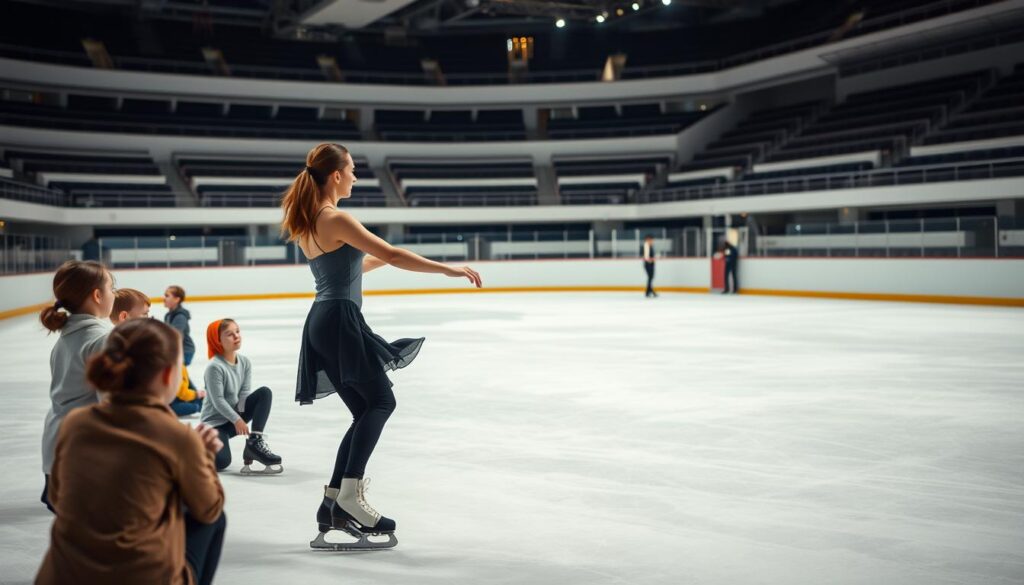
Professional ice skating instructors share a lot of knowledge with beginners. They help change how you learn to stop and skate better.
Top instructors say to focus on these key areas for getting better:
- Maintaining proper body alignment
- Developing core strength
- Practicing mental visualization
- Understanding weight distribution
Experts say breaking down hard moves into simple parts helps a lot. This builds confidence and muscle memory.
| Skill Level | Key Focus Areas | Practice Frequency |
|---|---|---|
| Beginner | Balance and Basic Stops | 2-3 times per week |
| Intermediate | Advanced Stopping Techniques | 3-4 times per week |
| Advanced | Precision and Speed Control | 4-5 times per week |
Experts stress the need for patience and consistent practice in learning to skate. Getting mentally ready is key to feeling confident on the ice.
Learning from pros can speed up your skating skills. They teach strategies to beat common problems and build a strong skill base.
Conclusion
Learning to stop on ice is a big step for beginners. The skills you’ve learned make you feel more confident on the ice. Every stop you make shows you’re getting better, turning possible falls into moments of skill.
The tips from this guide are more than just steps to follow. They open the door to a fun winter sport. You now have a set of skills, from basic to advanced, to enhance your skating. Remember, getting better takes practice and patience.
Your skating journey is special. It doesn’t matter if you skate for fun, fitness, or competition. The stopping techniques you’ve learned will help you grow. Skating pros say knowing your edges and body is key to getting good.
The rink is waiting for you to show off your new skills. See each practice as a chance to get better, build muscle, and enjoy ice skating. Your journey is just starting, and every step brings you closer to being the skater you dream of.
